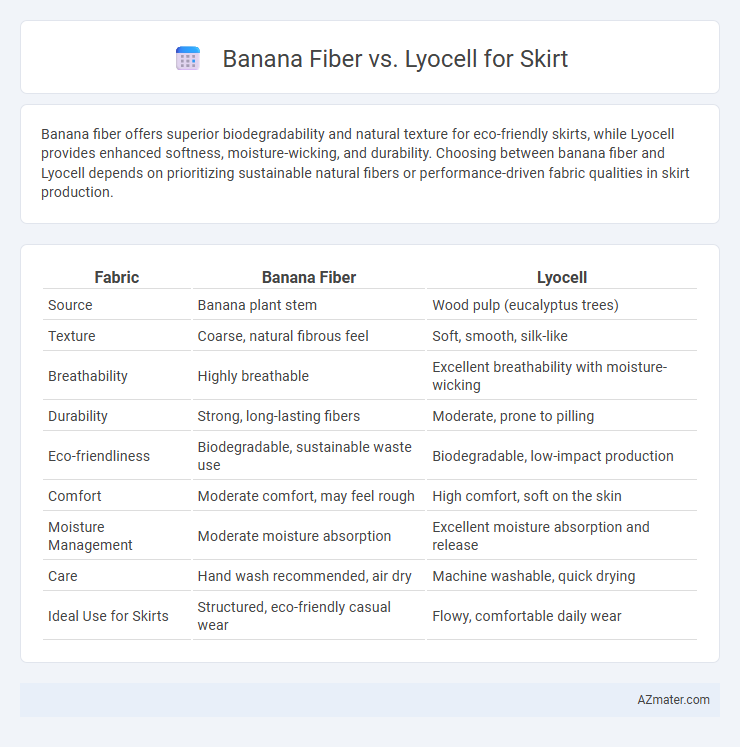Banana fiber offers superior biodegradability and natural texture for eco-friendly skirts, while Lyocell provides enhanced softness, moisture-wicking, and durability. Choosing between banana fiber and Lyocell depends on prioritizing sustainable natural fibers or performance-driven fabric qualities in skirt production.
Table of Comparison
| Fabric | Banana Fiber | Lyocell |
|---|---|---|
| Source | Banana plant stem | Wood pulp (eucalyptus trees) |
| Texture | Coarse, natural fibrous feel | Soft, smooth, silk-like |
| Breathability | Highly breathable | Excellent breathability with moisture-wicking |
| Durability | Strong, long-lasting fibers | Moderate, prone to pilling |
| Eco-friendliness | Biodegradable, sustainable waste use | Biodegradable, low-impact production |
| Comfort | Moderate comfort, may feel rough | High comfort, soft on the skin |
| Moisture Management | Moderate moisture absorption | Excellent moisture absorption and release |
| Care | Hand wash recommended, air dry | Machine washable, quick drying |
| Ideal Use for Skirts | Structured, eco-friendly casual wear | Flowy, comfortable daily wear |
Introduction to Sustainable Fibers in Fashion
Banana fiber and lyocell represent innovative sustainable fibers gaining popularity in eco-friendly fashion, particularly for skirts. Banana fiber is derived from the pseudostem of banana plants, offering a biodegradable, strong, and breathable textile ideal for natural and artisanal styles. Lyocell, made from sustainably sourced wood pulp through a closed-loop process, delivers a soft, moisture-wicking, and durable fabric favored for its eco-conscious production and versatility in elegant skirt designs.
What is Banana Fiber?
Banana fiber is a natural textile fiber extracted from the pseudostem of the banana plant, known for its durability, biodegradability, and eco-friendliness. Unlike lyocell, which is made from chemically processed wood pulp, banana fiber offers a more sustainable choice with minimal environmental impact due to its renewable source and low water usage. Its coarse texture makes it ideal for structured skirts, providing a unique blend of strength and breathability in sustainable fashion.
What is Lyocell?
Lyocell is a sustainable fabric made from wood pulp, primarily sourced from eucalyptus trees, known for its soft texture and high moisture absorption. It offers excellent breathability and durability, making it ideal for skirts that require both comfort and resilience. Compared to banana fiber, which is coarser and more textured, lyocell provides a smoother finish and better drape, enhancing the garment's aesthetic appeal.
Environmental Impact: Banana Fiber vs Lyocell
Banana fiber is derived from agricultural waste, making it a highly sustainable and biodegradable option with minimal chemical processing, thus reducing environmental pollution. Lyocell, produced from sustainably sourced wood pulp through a closed-loop process, offers biodegradability and water efficiency but involves higher energy consumption during manufacturing. Choosing banana fiber skirts significantly lowers carbon footprint and waste compared to lyocell, emphasizing circular economy principles in sustainable fashion.
Comfort & Texture: Fabric Feel Comparison
Banana fiber offers a coarse and textured feel with natural stiffness, providing durability but less softness against the skin compared to Lyocell. Lyocell fabric is renowned for its silky smooth texture and excellent breathability, making skirts exceptionally comfortable for all-day wear. The moisture-wicking properties of Lyocell enhance comfort by keeping the skin dry, whereas banana fiber may feel rougher and less flexible in comparison.
Durability and Longevity in Skirt Use
Banana fiber offers exceptional durability due to its strong cellulose structure, making it highly resistant to wear and tear in skirt use. Lyocell, while soft and breathable, tends to have moderate durability and may weaken with frequent washing or abrasion. For long-lasting skirts, banana fiber provides superior longevity, retaining shape and strength over extended periods compared to Lyocell.
Breathability and Moisture Management
Banana fiber offers excellent breathability due to its porous, natural cellulose structure, making it ideal for skirts in warm climates by promoting airflow and reducing heat retention. Lyocell, a man-made cellulose fiber, excels in moisture management by efficiently wicking sweat away from the skin and drying quickly, enhancing comfort during prolonged wear. Both materials provide sustainable alternatives with banana fiber favoring ventilation and Lyocell prioritizing moisture control for optimal skirt performance.
Aesthetic Appeal and Design Versatility
Banana fiber offers a unique, coarse texture with natural luster that lends skirts an earthy, artisanal aesthetic often favored in bohemian and eco-conscious fashion. Lyocell provides a smooth, silky finish with excellent drape, enabling versatile skirt designs from structured silhouettes to flowy styles that enhance wearability and elegance. Both fibers support sustainable fashion, but banana fiber stands out for its raw, organic charm while lyocell excels in refined, modern aesthetics.
Cost and Accessibility for Consumers
Banana fiber skirts generally have higher production costs due to labor-intensive extraction and limited large-scale manufacturing, making them less accessible and more expensive for consumers. Lyocell skirts benefit from established production methods and widespread availability, resulting in lower costs and greater market accessibility. Consumers seeking affordable and easily obtainable sustainable skirt options typically find Lyocell a more practical choice compared to banana fiber.
Which Fiber is Better for Skirts?
Banana fiber offers exceptional strength, natural breathability, and eco-friendliness, making it ideal for durable, sustainable skirts with a unique texture. Lyocell provides superior softness, moisture-wicking properties, and a smooth drape, enhancing comfort and elegance in skirt designs. For skirts requiring robust structure and environmental sustainability, banana fiber excels, while lyocell is better suited for soft, flowy silhouettes prioritizing comfort and ease of care.

Infographic: Banana fiber vs Lyocell for Skirt
 azmater.com
azmater.com